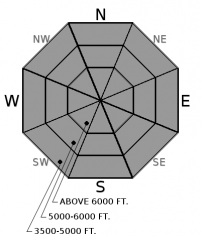| Saturday | Saturday Night | Sunday | |
|---|---|---|---|
| Cloud Cover: | Partly cloudy with gusty winds. | Cool temperatures with breezy conditions. | High pressure strengthens. |
| Temperatures: | 26-33 deg. F. | 12-20 deg. F. | 26-33 deg. F. |
| Wind Direction: | West | Southwest | Southwest |
| Wind Speed: | 14-20 mph with gusts to 40 | 9-12 mph with gusts to 32 | 7-10 mph with gusts to 24 |
| Snowfall: | 1-4 in. | 0 in. | 0 in. |
| Snow Line: |
Whitefish Range
Swan Range
Flathead Range and Glacier National Park
How to read the forecast
Strong winds overnight continue to form and thicken wind slabs, especially in the alpine. Recent heavy precipitation and fluctuating temperatures have stressed our weak snowpack structure. The avalanche danger is CONSIDERABLE above 5000 feet. You are likely to trigger a wind slab avalanche today and it is possible to trigger an avalanche on a buried weak layer. Conservative decision-making remains essential on all aspects.

3. Considerable
?
Above 6500 ft.
3. Considerable
?
5000-6500 ft.
2. Moderate
?
3500-5000 ft.
- 1. Low
- 2. Moderate
- 3. Considerable
- 4. High
- 5. Extreme
-
Type ?
-
Aspect/Elevation ?

-
Likelihood ?CertainVery LikelyLikelyPossible
 Unlikely
Unlikely -
Size ?HistoricVery LargeLargeSmall

At upper elevation locations there is still plenty of snow available for transport above the recent rain line. In the past 24 hours top wind speeds averaged 12-50 mph with gusts up to 61. In the alpine region of our area wind slabs will continue to form and thicken today. During our recent storm cycle variable wind direction formed wind slabs on all aspects at mid and upper elevations. It is likely that you could trigger a wind slab avalanche today, particularly in the alpine.
-
Type ?
-
Aspect/Elevation ?

-
Likelihood ?CertainVery LikelyLikelyPossible
 Unlikely
Unlikely -
Size ?HistoricVery LargeLargeSmall

The storm cycle that we enjoyed over the past week buried existing weak layers an additional 2-4+ feet. Some of the avalanche activity that occurred this week was associated with these weak layers, particularly the weak snow surrounding the January 19 crust. There still remain isolated areas of buried surface hoar beneath the new snow and depth hoar can be found in many locations at the bottom of our pack. As the snow pack adjusts to the recent load it is best to be conservative in terrain choices today. Whumfing sounds (collapsing) of the snow pack while traveling across the snow is an obvious sign of instability.
Dangerous conditions also exist at mid-elevation terrain. The snow structure is weak and was not a previous concern before the last series of storms due to the lack of a cohesive slab. Now we have a thick slab above this layer. Pay attention to sneaky slopes, steep pitches, and cut banks well below the tree-line.
Ladies, are you interested in refreshing your avalanche knowledge or looking for a great introduction to avalanche safety? If so, join us at The White Room Mountain Shop, in Whitefish, on Thursday, February 16th at 6:30 pm for a free, engaging, and entertaining 1 hour avalanche awareness presentation. The class includes general information about avalanche hazard, how to avoid it, and proper equipment for traveling in avalanche terrain.
Friday: Mark traveled in the backcountry east of the WMR ski area in the southern Whitefish Range. Numerous crowns from recent avalanche activity were noted on both north and south facing aspects. These avalanches occurred during both the February 4-6 storm and the February 8-9 storm. At upper elevations a dense 8 inches thick storm slab was resting on top of approximately 24 inches of recent low density snow.
Thursday: BNSF Avalanche Safety Team reported natural avalanche activity in John F. Stevens Canyon in southern Glacier Park. One large magnitude avalanche deposited 6-8 feet of debris that was 150 feet wide on the railway, and it also reached the highway. The powder blast from the avalanche was evident 25 feet up a power pole.
See below for all observations this season.
In the past 24 hours temperatures reached the upper 20s to low 30s with winds out of the southwest that averaged 10-50 mph with maximum gusts of 24-61 mph. Currently, temperatures above 6000 feet range from 17-23ºF, and winds are southwest at 7-33 mph with gusts from 17-52 mph. Today, we should see continued breezy conditions with temperatures in the mid 20s to low 30s.
| 0600 temperature: | 17-23 deg. F. |
| Max. temperature in the last 24 hours: | 26-34 deg. F. |
| Average wind direction during the last 24 hours: | South-Southwest |
| Average wind speed during the last 24 hours: | 10-50 mph |
| Maximum wind gust in the last 24 hours: | 24-61 mph |
| New snowfall in the last 24 hours: | 0 inches |
| Total snow depth: | 72-107 inches |
This advisory applies only to backcountry areas outside established ski area boundaries. This advisory describes general avalanche conditions and local variations always occur. This advisory expires at midnight on the posted day unless otherwise noted. The information in this advisory is provided by the USDA Forest Service who is solely responsible for its content.































